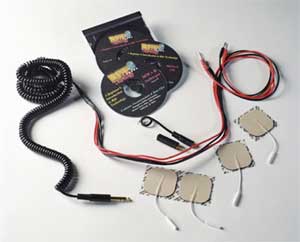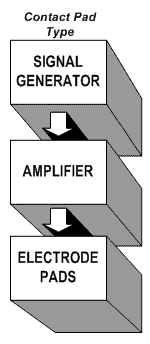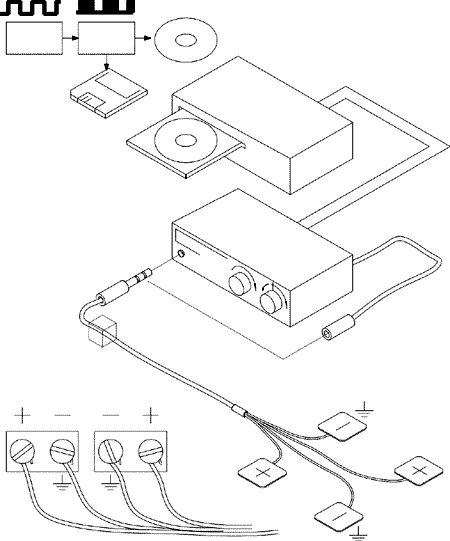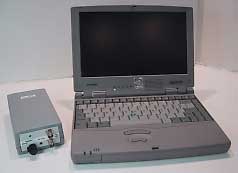Contact Devices
 |
 |
A contact device for the beginning experimenter can be as simple as contacts connected to an audio sound system. There are of course some disadvantages to this, which are discussed in detail as well as elsewhere in this book, but it does allow an experimenter the basic resources and to grasp the underlying concepts so that he may decide to progress on to a more developed system more appropriate or something tailored for his particular requirements.

SIGNAL GENERATOR – The basic input signal can be created by a wide variety of devices, from a laboratory grade function generator, to a simple computer generated audio waveform. This device generates the specific audio waveform at our target frequencies, and in the case of square waves, their harmonics as well. Good laboratory grade frequency and function generators can be quite expensive and not typically easy for most folks to understand and use. They provide functions many folks will not ever need for Rife work. Computer generation and versatility has become a very versatile preference for many folks. In the “Frequency Generation” document I will discuss in detail many of the practical applications and considerations for good Rife experimentation.
AMPLIFIER – The voltage/signal generated by most audio generation devices is typically quite low and is often at a specific impedance designed to be received by an electrical component, such as a speaker. The body is not a speaker, and appears as a very mismatched high impedance device to the generating circuit. A considerable voltage drop exists when the “human element” is added into the circuit. The easiest, (but not necessarily the best way), is to simply amplify the audio output from the sound generating device. This has been done using a good quality home amplifier and can serve to introduce the new experimenter to the basics at very minimal cost.
As suggested above, simple audio amplification is NOT the best way of providing a “stronger” signal. Ideally, the increase in the output voltage should be done in the circuitry immediately following the actual signal generation, taking into consideration, therefore maintaining accurate purity of original waveform. Additionally, consideration needs to be made as to the output impedance (contact with the body) so as to also maintain waveform as much as possible. Some of these issues will also be discussed in the “Frequency Generation” document.
Note: This is essentially what we have done on one of the variable output of the SquareGENsp+ … specifically designed for contact type experimentation. (the other 2 outputs are appropriate outputs for HV and Bare-Rife experimentation.
ELECTRODE PADS – these commercially available, disposable or reusable, contact pads are specifically designed to very efficiently transfer small voltages and micro-currents into the tissues when applied to the body. It is my understanding, studies have shown them to be approximately 10 times as efficient in transferring energy as a hand-hold type device. Other examples of electrodes commonly available, materials which have been substituted for quality electrodes with probably lesser results, are copper and/or stainless steel pipes or cylinders, metal plates, even water filled pie pans with alligator clip leads. I personally prefer the quality and versatility of direct and focused application of medical or sports grade reusable adhesive electrode pads.
The simple contact type device can initially be used for the beginning experimenter to delve into the basic concepts of Rife. Recorded signals can be played on a home stereo of sufficient power. The experimenter is however limited to the recorded frequencies and to an accuracy of the playback device.
The next stage in the experimenters evolution is to replace the CD player shown here, with a computer and installed appropriate software for targeted sound generation.
 |
| This setup represents a very modest setup within the grasp of almost any prospective experimenter. In most cases, the experimenter will already have most of what is needed except for the specialized cable and conductive electrode pads, similar to what is shown below. Both can be easily obtained and/or constructed by the user with readily available materials. The Device Construction area will go into more detail on this. A purchasable equivalent is available in the RIFEforLIFE.com website in the form of the “Experimenter Kit” |
 |
 |
| SquareGENsp+ and Laptop for Frequency Generation and appropriate Amplification and or Drive for Contact Pads | |
From a functional flow diagram standpoint, this provides a very similar setup as the simple experimenter kit using a home audio amplifier, however, the SquareGEN sp+ provides exceptional quality output most likely exceeding what is available even in many commercial test or laboratory grade function generators. While it also outputs at 50 ohms for the PMR/High Voltage and the Bare-Rife Type devices … in this case we are using the third, high impedance output to more appropriately match with what might be found if contacts are placed on the surface of human or animal skin. The voltage output on this connector is typically in excess of 36 volts and is user adjustable via a gain control on the front panel.
Note: In the previous functional flow, the amplifier is also now replaced as a function of the SquareGEN . Rather than the audio output being boosted, SquareGen boosts the waveform voltage appropriately on that output only.
Because we have used standard audio connectors on this output, a simple stereo extension cable can be used to extend the length for easy remote use.

